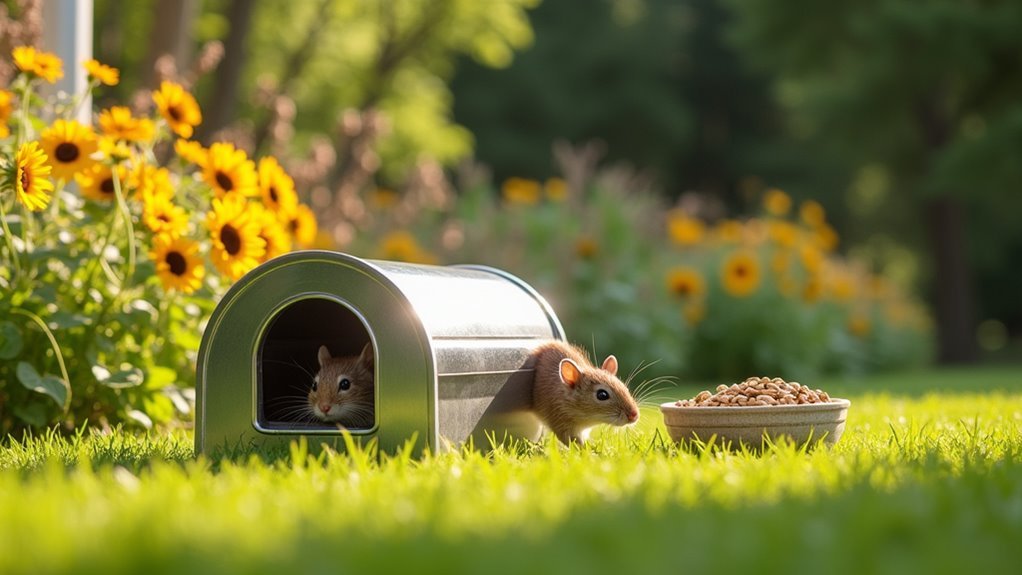You can eliminate rodents safely by using live traps with peanut butter bait, electronic traps with pet-secure housings, and natural deterrents like peppermint oil or used cat litter. Install ultrasonic emitters that repel rodents without chemicals, store all food in airtight containers, and seal entry points with steel wool. Maintain spotless kitchen surfaces and consider professional-grade pet-safe rodenticides for severe infestations. Combining multiple methods while rotating strategies guarantees your home stays rodent-free without endangering your beloved pets.
Live Traps for Humane Capture and Release

When you’re dealing with unwanted mice but want to protect both your pets and the rodents themselves, live traps offer the perfect solution for humane capture and release.
These pet safe devices allow you to capture mice without causing harm, unlike traditional snap traps that pose risks to curious pets and wildlife.
You’ll want to bait your live traps with peanut butter, nuts, or fruit to effectively attract mice.
Place them where you’ve noticed signs of activity like droppings or gnaw marks. Regular monitoring is essential for humane treatment – check traps frequently to avoid stress to captured animals.
Once you’ve caught a mouse, release it at least a mile from your home to prevent return.
These humane methods provide effective rodent control while maintaining your commitment to animal welfare.
Electronic Traps With Pet-Safe Design
While live traps work well for those committed to catch-and-release methods, electronic traps offer a more efficient solution that eliminates rodents instantly while keeping your pets completely safe.
These advanced devices use built-in sensors to detect intrusions and deliver instant electric shocks for quick, humane kills. You’ll find many models designed specifically to be safe around pets, featuring secure housings that prevent pet access to bait stations.
Modern electronic rodent traps combine smart sensor technology with pet-safe housing designs to deliver efficient, humane pest control solutions.
Light indicators notify you when a rodent’s been captured, eliminating constant monitoring that might disturb your animals. Unlike traditional snap traps that risk injury, electronic traps contain lethal mechanisms within protective enclosures.
Companies like EcoClear Products manufacture electronic traps prioritizing both effective rodent control and pet safety.
Natural Deterrents Using Essential Oils and Spices

If you’re seeking gentler alternatives that won’t harm your pets, natural deterrents using essential oils and spices provide an effective first line of defense against rodent invasions.
These pet-safe methods work by creating scent barriers that mice find repulsive:
- Peppermint oil – Soak cotton balls and place them around kitchens and pantries where mice frequent.
- Cinnamon and cayenne pepper – Sprinkle these spices in active areas, ensuring pets can’t access them.
- Camphor – Place in old socks near vents or windows, but keep away from living spaces.
- Used kitty litter – Strategically position to signal cat presence without actual feline exposure.
Remember that essential oils and spices require regular replacement to maintain their potency.
While these natural deterrents won’t eliminate existing infestations immediately, they create hostile environments that discourage new rodent activity.
Ultrasonic Emitters for Chemical-Free Repelling
You’ll find ultrasonic emitters offer a completely chemical-free approach to rodent control that’s safe for your pets and family.
These devices emit high-frequency sound waves that disrupt rodents’ communication and navigation systems, creating stress that encourages them to leave your property.
Understanding how this technology works and where to place these units will maximize their effectiveness in protecting areas up to 5,000 square feet.
How Ultrasonic Technology Works
Ultrasonic emitters offer a chemical-free approach to rodent control by producing high-frequency sound waves that humans can’t hear but effectively disturb and repel unwanted pests.
These devices keep rodents from your home while remaining safe around your beloved pets and family members.
The technology operates through these key mechanisms:
- Sound wave emission – Devices produce frequencies between 20-65 kHz that target rodent hearing ranges.
- Area coverage – Sound waves spread throughout rooms, garages, and other spaces without chemical residue.
- Behavioral disruption – High-frequency sounds create uncomfortable environments that encourage rodents to relocate.
- Obstacle sensitivity – Walls and furniture can interfere with sound propagation, requiring strategic placement.
You’ll maximize effectiveness by combining ultrasonic emitters with complementary pet-safe methods for thorough rodent prevention.
Effectiveness and Placement Tips
While ultrasonic emitters offer promising results for many homeowners, their effectiveness depends heavily on proper placement and realistic expectations.
You’ll achieve ideal results by installing these pet-safe devices in areas with suspected rodent activity like kitchens, basements, and attics. Confirm nothing obstructs the soundwaves – furniture and walls can greatly reduce effectiveness.
Each emitter covers up to 1,200 square feet, making them ideal for enclosed spaces and small apartments.
Don’t set them and forget them; regularly check and reposition your devices to maintain peak performance. Rodents can become accustomed to static emitters over time, so occasional repositioning is essential.
For maximum effectiveness, combine ultrasonic technology with other pet-safe methods like sealing entry points and maintaining cleanliness throughout your home.
Strategic Food Storage and Kitchen Hygiene

You’ll find that controlling food sources represents one of the most effective ways to eliminate rodents without endangering your pets.
Proper food container sealing prevents mice from accessing their primary motivation for entering your home, while consistent kitchen surface maintenance removes the crumbs and residues that initially attract them.
These straightforward hygiene practices create an environment that’s naturally inhospitable to rodents while keeping your furry family members completely safe.
Proper Food Container Sealing
Since rodents can squeeze through surprisingly small openings to reach food sources, securing your kitchen and pantry becomes your first line of defense against unwanted visitors.
Proper food container sealing creates an impenetrable barrier that’s safe for pets while effectively addressing your rodent problem.
Implement these essential sealing strategies:
- Choose thick plastic or glass containers with secure, tight-fitting lids that rodents can’t chew through.
- Store pet food and treats in airtight containers immediately after opening original packaging.
- Transfer bulk items like grains and cereals into rodent-proof bins to eliminate access points.
- Inspect container seals regularly to guarantee they remain intact and effective.
This approach eliminates food sources without using harmful chemicals that could endanger your pets’ health and safety.
Clean Kitchen Surface Maintenance
Beyond securing your food containers, maintaining spotless kitchen surfaces becomes equally important for keeping rodents away from your home.
Clean kitchen surface maintenance involves wiping down countertops, stovetops, and cutting boards immediately after food preparation to eliminate crumbs and residues that attract mice. You’ll need to store all food items, including pet food, in sealed containers since even tiny amounts can entice rodents indoors.
Clean up spills immediately and remove garbage promptly to reduce potential food sources.
Vacuum frequently under appliances and in hidden corners where debris accumulates. These areas often harbor food particles that provide sustenance for mice seeking shelter.
Regular inspection of storage areas helps identify potential entry points that require sealing with steel wool.
Sealing Entry Points With Steel Wool Barriers
When it comes to creating an impenetrable barrier against rodent intrusion, steel wool stands out as one of the most effective materials you can use.
Unlike other deterrents, mice can’t chew through steel wool, making it perfect for protecting your home while keeping your pets safe from harmful chemicals or dangerous traps.
Steel wool provides a chemical-free, pet-safe solution that creates an impenetrable barrier mice simply cannot penetrate.
Here’s how to maximize steel wool effectiveness at entry points:
- Combine with caulk or foam – Pack steel wool into gaps, then seal with caulk for extra durability.
- Target quarter-inch openings – Mice squeeze through surprisingly small spaces around pipes and foundations.
- Inspect regularly – Check sealed areas monthly since steel wool can rust over time.
- Focus on vulnerable areas – Prioritize walls, foundations, and utility penetrations where rodents commonly enter.
Cat Litter and Predator Scent Marking
While physical barriers like steel wool block rodents mechanically, you can also harness nature’s own deterrent system through predator scents.
Used cat litter creates an effective mouse repellent by signaling a cat’s presence in your home. Simply fill an old sock with used litter and place it strategically in areas where you’ve noticed mouse activity.
This pet-safe method doesn’t involve toxic chemicals or poisons that could harm your family pets. The scent naturally discourages rodents from entering treated areas since they instinctively avoid predator territories.
For best results, position these litter-filled socks in outdoor spaces, garages, or basements where odor won’t be problematic. This inexpensive, eco-friendly approach offers a practical alternative to traditional rodent control while keeping your household safe.
Professional-Grade Pet-Safe Rodenticides
Though traditional rodenticides pose serious risks to pets through accidental ingestion or secondary poisoning, professional-grade pet-safe alternatives offer powerful rodent control without compromising your family’s safety.
Professional-grade pet-safe rodenticides deliver effective pest control while eliminating the dangerous chemical risks that threaten your family and pets.
These advanced rodenticides use natural ingredients that specifically target rodent physiology while protecting pets and wildlife from harm.
You’ll find these products eliminate secondary poisoning risks that endanger cats, dogs, and other predatory animals.
Key advantages of professional-grade pet-safe rodenticides include:
- Natural formulations that disrupt rodent biology without toxic chemicals
- Humane extermination methods that minimize rodent suffering
- Made in the USA with rigorous quality standards like EcoClear Products
- Effective population control while maintaining household safety
You can now manage rodent infestations confidently, knowing you’re protecting both your family and pets from dangerous chemical exposure.
Maintaining Clean Environments to Reduce Attraction
Since rodents are naturally drawn to accessible food sources and shelter, maintaining a spotless environment serves as your first line of defense against infestations.
You’ll want to clean surfaces thoroughly after food preparation and vacuum regularly to eliminate crumbs that attract rodents. Store both pet food and human food in airtight containers, making them inaccessible to mice seeking easy meals.
Secure your trash cans with tight-fitting lids and don’t leave bags sitting out.
Outdoor areas need attention too—promptly clean up fallen fruits, pet waste, and scattered bird food that can lure rodents to your property.
Finally, seal any holes or gaps with steel wool or copper mesh to prevent entry points.
These simple maintenance habits create an unwelcoming environment for unwanted guests.
Combining Multiple Methods for Maximum Effectiveness
Although individual rodent control methods can prove effective on their own, you’ll achieve superior results by implementing multiple strategies simultaneously.
Combining traps with natural deterrents like peppermint oil creates a thorough defense system for your home. When one method fails, others continue protecting your space from unwanted visitors.
Here’s how to maximize your multi-method approach:
- Rotate bait types in traps regularly to prevent mice from becoming accustomed to specific lures.
- Reapply natural deterrents frequently to maintain their potency and effectiveness.
- Monitor rodent activity closely and adjust your strategy based on observed patterns.
- Seal entry points while maintaining active traps and deterrents throughout your home.
This layered strategy guarantees you’re addressing the problem from multiple angles, greatly increasing your chances of complete elimination.
Frequently Asked Questions
How to Get Rid of Mice Without Harming Your Pet?
You’ll want to use live traps and release mice far away, seal entry points with steel wool, apply natural deterrents like cinnamon, and store pet food in sealed containers safely.
What Kills Rats but Is Safe for Pets?
You can use electronic traps that deliver instant electric shocks while keeping pets safe through contained designs. The A24 trap uses CO2-powered mechanisms, and ultrasonic emitters deter rats without affecting pets.
How Do I Get Rid of Rats in My Yard Without Harming My Pets?
You’ll want to secure pet food in sealed containers, sprinkle cayenne pepper around your yard, use live traps away from pet areas, clean up debris regularly, and seal entry points with steel wool.
What Do Rodents Hate Most?
Rodents hate strong scents most, especially peppermint oil, which they’ll actively avoid. You’ll find camphor, cayenne pepper, cinnamon, and cat odors also repel them effectively since these smells irritate their sensitive noses.
In Summary
You’ve now got multiple pet-safe options to tackle your rodent problem without putting your furry friends at risk. Don’t rely on just one method—combine several approaches like sealing food sources, using natural deterrents, and setting humane traps for maximum effectiveness. Remember, consistency’s key to success. Start implementing these strategies today, and you’ll create an environment that’s unwelcoming to rodents while keeping your pets completely safe and healthy.





Leave a Reply